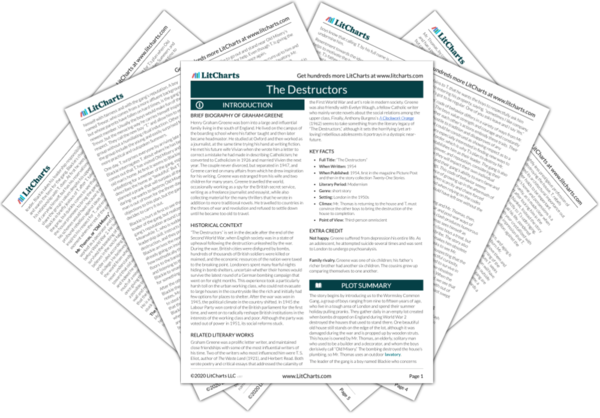Welcome to the LitCharts study guide on Graham Greene's The Destructors. Created by the original team behind SparkNotes, LitCharts are the world's best literature guides.
The Destructors: Introduction
A concise biography of Graham Greene plus historical and literary context for The Destructors.
The Destructors: Plot Summary
A quick-reference summary: The Destructors on a single page.
The Destructors: Detailed Summary & Analysis
In-depth summary and analysis of every part of The Destructors. Visual theme-tracking, too.
The Destructors: Themes
Explanations, analysis, and visualizations of The Destructors's themes.
The Destructors: Quotes
The Destructors's important quotes, sortable by theme, character, or part.
The Destructors: Characters
Description, analysis, and timelines for The Destructors's characters.
The Destructors: Symbols
Explanations of The Destructors's symbols, and tracking of where they appear.
The Destructors: Theme Wheel
An interactive data visualization of The Destructors's plot and themes.
Brief Biography of Graham Greene
Henry Graham Greene was born into a large and influential family living in the south of England. He lived on the campus of the boarding school where his father taught and then later became headmaster. He studied at Oxford and then worked as a journalist, at the same time trying his hand at writing fiction. He met his future wife Vivian when she wrote him a letter to correct a mistake he had made in describing Catholicism; he converted to Catholicism in 1926 and married Vivien the next year. The couple never divorced, but separated in 1947, and Greene carried on many affairs from which he drew inspiration for his writing. Greene was estranged from his wife and two children for many years. Greene travelled the world, occasionally working as a spy for the British secret service, writing as a freelance journalist and essayist, while also collecting material for the many thrillers that he wrote in addition to more traditional novels. He travelled to countries in the throes of war and revolution and refused to settle down until he became too old to travel.
Get the entire The Destructors LitChart as a printable PDF.

Historical Context of The Destructors
“The Destructors” is set in the decade after the end of the Second World War, when English society was in a state of upheaval following the destruction unleashed by the war. During the war, British cities were disfigured by bombs, hundreds of thousands of British soldiers were killed or maimed, and the economic resources of the nation were taxed to the breaking point. Londoners spent many fearful nights hiding in bomb shelters, uncertain whether their homes would survive the latest round of a German bombing campaign that went on for eight months. This experience took a particularly harsh toll on the urban working class, who could not evacuate to large houses in the countryside like the rich and initially had few options for places to shelter. After the war was won in 1945, the political climate in the country shifted. In 1945 the Labour Party won control of the British parliament for the first time, and went on to radically reshape British institutions in the interests of the working class and poor. Although the party was voted out of power in 1951, its social reforms stuck.
Other Books Related to The Destructors
Graham Greene was a prolific letter writer, and maintained close friendships with some of the most influential writers of his time. Two of the writers who most influenced him were T. S. Eliot, author of The Waste Land (1921), and Herbert Read. Both wrote poetry and critical essays that addressed the calamity of the First World War and art’s role in modern society. Greene was also friendly with Evelyn Waugh, a fellow Catholic writer who mainly wrote novels about the social relations among the upper class. Finally, Anthony Burgess’s A Clockwork Orange (1962) seems to take something from the literary legacy of “The Destructors,” although it sets the horrifying (yet art-loving) rebellious adolescents it portrays in a dystopic near-future.
Key Facts about The Destructors
- Full Title: “The Destructors”
- When Written: 1954
- When Published: 1954, first in the magazine Picture Post and then in the story collection Twenty-One Stories.
- Literary Period: Modernism
- Genre: short story
- Setting: London in the 1950s
- Climax: Mr. Thomas is returning to the house and T. must convince the other boys to bring the destruction of the house to completion.
- Point of View: Third-person omniscient
Extra Credit for The Destructors
Not happy. Greene suffered from depression his entire life. As an adolescent, he attempted suicide several times and was sent to London to undergo psychoanalysis.
Family rivalry. Greene was one of six children; his father’s richer brother had another six children. The cousins grew up comparing themselves to one another.












